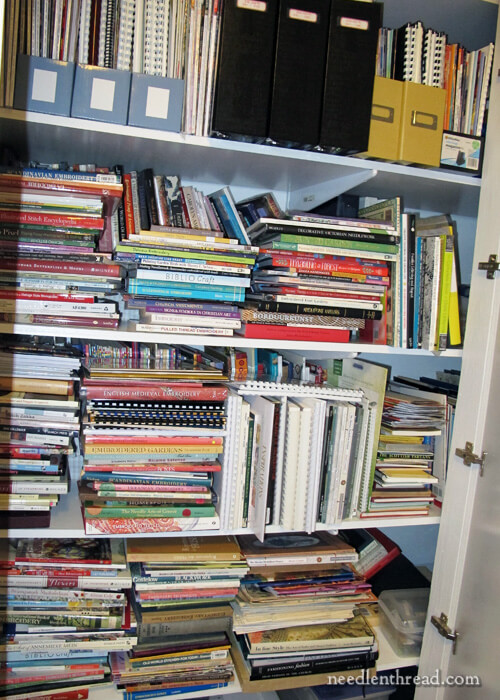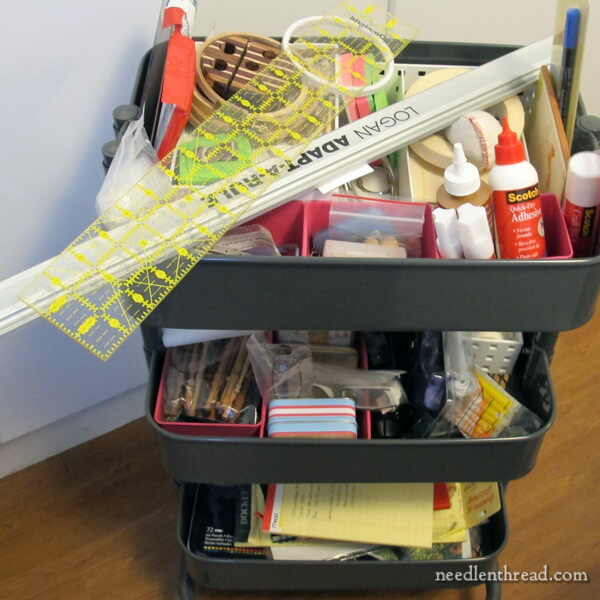Earlier this summer, I took you briefly into my embroidery workroom during a bout of organization.
Organizational bouts are not a once-in-a-lifetime deal. The trick to staying organized is the daily habit of putting things where they belong and the weekly or bi-weekly habit of tweaking the system, cleaning thoroughly, and all that. Admittedly, I preach this, but I don’t always live it! I’m no maven of organization, and I don’t pretend to be. It’s just not my personality. I don’t have a specific system that I adhere to fiendishly, as part of a personal challenge, lifestyle, or mental strategy. My workroom is functional more than anything else, and it’s a luxury insofar as it’s a dedicated needlework area, but it’s not luxurious. After chatting about that bout of organization, a discussion opened about workroom essentials. I’ve put together my list of essential things in or about my workroom that help my workflow and keep me semi-organized. At the end of the article, I include a few little luxuries and some suggestion to think about if you’re planning your dream space for needlework.  1. Cabinets with doors. There are two reasons I love my cabinets with doors: 1. doors cut down on dust and and light, both of which can be detrimental (over time) to textile-related (and other) goods. 2. The closed doors deliver at least an external appearance of order when I walk into the room, which makes it much easier to get work done. I love the fact that the majority of my book collection is in a closed cabinet:  I keep my most frequently accessed books on small shelves that support a small table top under one of the windows. 2. A central work table. Preferably one that isn’t always piled with the latest project stuff, but alas… 3. Lighting. The overhead lighting in my workroom is shoddy in general, but that’s ok, because I have several good floor lamps and a desk lamp that I can move around to use where I need them. Besides providing me with good light for stitching, they work great for photography, too. 4. An ironing board and an iron. I keep the ironing board folded up behind the door, so it’s not taking floor space, which is limited. I take it out when I need it and put it back when I’m finished. I’ve tried all kinds of irons over the years, until I finally have what I consider the ideal iron for the work I do. It’s a dry iron, so there’s no steam function on it – it’s a flat, smooth plate. It’s especially ideal for iron-on transferring of designs, but I use it for everything I need to iron. I love my iron. You can find the dry iron I use on Amazon here, if you’re looking for one. 5. Chair and stool. While ideally, it might be great to have a comfy chair for stitching in my workroom – say, a really cozy corner with a cushy chair – I don’t have room for that, and I don’t stitch as efficiently when I’m cozied up on the couch. I have a desk chair on wheels with decent back support on one side of my table. On the other side, I have a stool of sorts. The stool that I use is called a Buoy (you can find the Buoy here on Amazon , if you want to see what they’re all about). It’s very convenient – it swivels, raises, lowers, tilts and rocks, and is an easy-up, easy-down type of seat. It’s lightweight and easy to move around. And it keeps me from sitting in the same position for long stretches. If you need or want absolute stability in a seat, though, this wouldn’t be the way to go. It rocks and tilts. I’ve had mine for years, since my teaching days, and I love it. I don’t get back aches, which I chalk up to the constantly small movements that keep me from sitting in the same position. I use it at the table, at my computer, and with most of my embroidery stands, especially trestles. You can see my stool in this picture:  6. Containers for general storage. I use plastic containers with lids. While plastic might not be that great for long-term, archival storage of, say, museum quality stuff, for my everyday supplies and the goods that I’ve got in my cabinets, they work fine. I prefer lower, flatter storage boxes with lock-on lids. If the storage boxes are too deep, they can end up too heavy to move conveniently. 7. A cutting mat. I keep it in the center of my worktable. This is useful not just for cutting, but for measuring and blocking things. 8. Floor stands. I have several floor stands and a set of trestles. I use them all to one degree or another. I probably use the Needlework System 4 stand the most frequently.  9. Thread cabinets. I use these Bisley collectors cabinets to store my collections of threads, especially my good threads and my most frequently used threads. These cabinets are the supports for my work table in the center of the room, so they contribute to saving space and they provide a good, clean storage solution for needlework threads. 10. Tool carts. I have a couple of these three-tiered wheel carts that I wrote about a while ago. They hold tools and art supplies that I use constantly, and I can wheel them up to the table when I need them, or away from the table when I need room.  11. Hard floors (instead of carpeting). I’m So Glad I don’t have carpeting in my workroom. It’s far easier to sweep and even vacuum a hard floor than it is to thoroughly vacuum a carpeted room. Plus it’s a lot easier to find dropped things! Because this is a garage remodel, the floor in my room is actually a laminate that looks like a wood floor, but isn’t one. If I could do it all over again and hang the expense, of course I’d have a wood floor – but I can’t, so I’m just wildly grateful for the floor I have, sans carpet! 12. Climate control. Normally, a garage is not heated and air-conditioned, but when this garage was first built, the house being so small, we needed to have an extra outlet for our central heat and air, as the unit was technically too large for the house. So we had the garage air-conditioned, and that worked out great for the future remodeling of it into a workroom. Heat and air are pretty essential in Kansas, for two reasons: 1. the climate; 2. the dirt. Open windows in Kansas = The 1930’s Dust Bowl re-enacted in your home on a daily basis. The Little ThingsThere are a few “little things” that make my work time in my workroom more enjoyable.1. Wifi. Since my workroom is separate from my house (it’s an attached garage on the back of the house, but not accessible from the house without going outside), I had the garage hardwired for internet and added a wifi extender to our household wifi, so that I had a good connection out there, too. 2. A bluetooth speaker for listening to music, audiobooks, podcasts, and so forth while working. If You Want It…If you’re setting up your dream needlework space, these are some points to consider:1. Give yourself at least one decent working tabletop, even if you tend to stitch in a comfortable chair rather than at a table. 2. Consider lighting. Are you going to use floor lamps? Overhead lighting? Table lamps? And make sure your electrical outlets are suited to what you need, or use extension cords. If you’re having a room built or remodeled, seriously consider the possibility of an electrical outlet in the floor in the center of the room. I wish I had one! 3. Consider movement paths. Make sure you have room to move around. And make sure you have room to set up an ironing board or a needlework frame, or other things that you might set up temporarily and then take down again. You should be able to move around those things when they’re set up, so keep in mind a good-sized blank space in the room. 4. Consider storage space. Closed cabinets are great! Not only do they hide a multitude of evil when things might get a little cluttered (so that you can close the doors and still have a sense of orderliness), but they are great for a reduced-dust and reduced-light environment for storing books, fabrics, and threads. I personally like deeper-than-normal cabinets. because they allow room for multi-sized storage containers to keep things on the insides of the cabinets organized. When you arrange your cabinets, arrange your most-accessed items in the easiest accessible areas. 5. Think in terms of under-table storage, too. Using storage options to support tabletops is a handy way of giving yourself more room without taking up floor space. 6. If you’re building from scratch, consider adding some good natural light. Although windows take up valuable wall space, the natural light they provide is great for stitching if you can arrange a chair by a sunny window, but it’s also pretty essential for setting the right kind of mood. That said, consider good shades, in case the light is too much, especially in summer, or in case you have projects out that you want to protect from too much light. 7. If you’re lucky enough to have the room, consider adding a corner where you can have a comfortable chair for stitching away from the main work table. I do most of my work at the table, including stitching, but if I had the space, I’d have a comfy corner, too. 8. Invest in a small collection of inexpensive pillowcases or sheets (flat crib sheets are a nice size) that you can use to cover projects that you leave out. 9. Invest in a good task chair – something that moves easily to different areas of the room, that’s comfortable for you, and that allows you a good range of motion for tasks. 10. The luxurious extras: consider entertainment options, like a bluetooth speaker for listening to music or audiobooks, or a small TV if you like TV…and a phone jack, if you use a landline! (I know, how archaic! But I’m glad I have one in my workroom!) Just In Case…And just in case you picture me working in some pristine area that’s immaculately organized, I snapped this photo for you at the end of my last work session: Gotta keep things real, after all! Over to YouDid I miss anything?What are some things you consider essential for a needlework studio or workroom? Chime in below with your suggestions, questions, comments, ideas, dreams….! The Amazon links mentioned above are affiliate links, which means Needle ‘n Thread receives a small kickback for any purchases made through them. |
Tuesday, September 19, 2017
Organizing your stitching space
I have been contemplating the rearrangement of my Happy Room which is my stitching space. Then came an article from Mary Corbet on that very subject...great minds and all. You can read said article at Needle and Thread.
Labels:
organization
Subscribe to:
Post Comments (Atom)
No comments:
Post a Comment